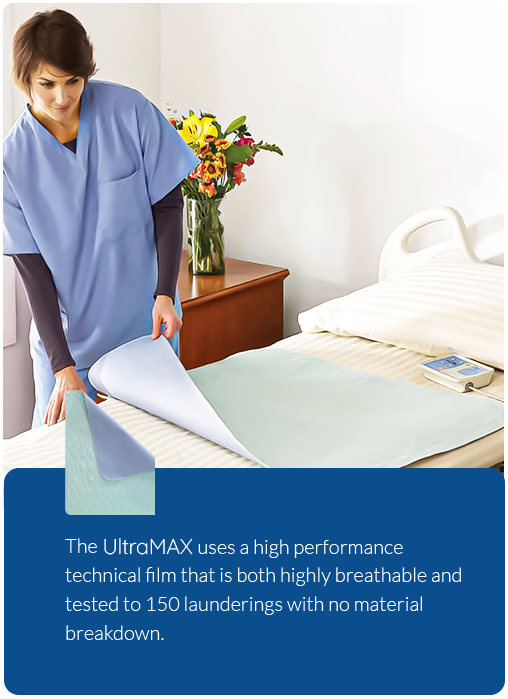When it comes to reusable vs disposable textiles in healthcare, the discussion revolves around cost-effectiveness, environmental impact, safety, and practicality. Healthcare facilities must make an informed decision that aligns with their operational goals and sustainability commitments.
This page aims to provide a comprehensive overview of the differences between reusable and disposable linen and apparel in the healthcare setting.
In this article, we’ll discuss:

Financial Costs: Reusable vs Disposable Textiles
Cost-efficacy is the most influential and controversial element of the debate between reusable vs disposable textiles. Reusable textiles, though initially more expensive, can offer long-term savings. To understand these cost dynamics better, explore our Underpad Cost Calculator, which provides a detailed comparison.

Initial Investment and Long-Term Savings
Reusable textiles typically require a higher initial investment compared to their disposable counterparts. This investment, however, can lead to significant long-term savings. Reusable options, due to their durability and longer life span, reduce the need for frequent repurchases. To better understand these financial dynamics, healthcare facilities can utilize tools like our Underpad Cost Calculator, which offers a clear comparison of the costs over time.
Maintenance and Operational Costs
Another factor in the cost analysis of reusable vs disposable textiles is the maintenance expense. Reusable textiles involve costs associated with laundering, sterilization, and storage. Efficient management of these processes is essential to maximize the cost-effectiveness of reusable textiles.
Waste Management and Disposal Costs
Disposable textiles, while lower in initial cost, incur ongoing expenses related to waste management and disposal. These costs can accumulate significantly over time, especially in high-volume healthcare settings. In contrast, reusable textiles contribute to lower waste management expenses.
Impact of Volume and Usage
The cost-effectiveness of reusable vs disposable textiles also depends on the volume and frequency of use. High-usage environments may find more economic benefit in reusable textiles due to the frequency of replacements required for disposables.
Long-Term Financial Planning
Incorporating reusable textiles into healthcare settings requires a strategic approach to financial planning. Facilities need to consider not only the immediate budgetary impacts but also the long-term financial benefits. This includes evaluating the return on investment over the lifespan of the textiles and the potential cost savings from reduced waste and disposal.
When deciding between reusable or disposable linen and apparel from a financial point standpoint, it’s essential to look beyond the surface. Long-term financial impacts, maintenance costs, waste management expenses, and usage patterns are essential factors for consideration.
Environmental Considerations: Single Use vs Reusable Textiles
The choice between single-use vs reusable textiles extends beyond financial aspects, significantly impacting the environment. Our commitment to sustainability is evident in our Green Commitment, which aligns with the benefits of choosing reusable options.

Environmental Impact of Disposable Textiles
Disposable textiles contribute to environmental degradation in several ways. The production process often involves the use of non-renewable resources and chemicals, leading to increased carbon emissions and ecological footprints. Moreover, the disposal of single-use textiles exacerbates landfill waste.
In contrast, reusable textiles offer a more sustainable alternative. The repeated use and laundering of these textiles significantly reduce waste generation. As highlighted in our Green Commitment, reusable options align with eco-friendly practices, contributing to waste reduction and minimizing the carbon footprint of healthcare facilities.
Energy and Water Usage
The environmental cost is not just about waste reduction. The laundering and sterilization of reusable textiles require energy and water. However, advancements in laundry technology have led to more energy-efficient and water-conserving methods. A study published in the American Journal of Infection Control (AJIC) demonstrates that modern laundering techniques for reusable textiles are increasingly environmentally friendly, effectively balancing hygiene with sustainability.
Lifecycle Analysis
A comprehensive lifecycle analysis of reusable vs disposable textiles by the TRSA reveals that reusable options often have a lower overall environmental impact. This analysis considers the entire lifecycle of the product, from production and usage to disposal. Reusable textiles, despite their energy and water usage during laundering, generally have a lower total environmental impact over their lifespan compared to disposables.
Regulatory and Compliance Aspects
Environmental regulations and compliance are also critical considerations. Healthcare facilities must adhere to strict waste management and disposal regulations. By opting for reusable textiles, facilities can reduce their regulatory burden and potential costs associated with waste disposal compliance.
Promoting a Culture of Sustainability
Beyond the tangible environmental costs, choosing reusable textiles reflects a commitment to sustainability. This commitment can resonate throughout the organization, promoting a culture of environmental responsibility and aligning with broader societal goals for sustainability.
The environmental cost considerations of reusable vs disposable textiles in healthcare encompass a range of factors, including waste reduction, energy and water usage, lifecycle impact, regulatory compliance, and the promotion of a sustainable organizational culture. By understanding and addressing these considerations, healthcare facilities can make decisions that positively impact the environment and align with their sustainability objectives.
Safety and Efficacy: Reusable vs Disposable Gowns and Textiles
The safety and efficacy of healthcare gowns are paramount. Both reusable and disposable gowns have their advantages and disadvantages. Reusable gowns, as highlighted in the AJIC Study on Reusable Gowns, however, offer more protection, often surpassing their disposable counterparts.

Material Durability and Integrity
The durability of gowns is essential for ensuring ongoing protection. Reusable gowns are generally made from robust materials designed to withstand repeated laundering and sterilization processes without degrading their protective qualities. In contrast, disposable gowns, while effective initially, are prone to wear and tear and are not designed for long-term use.
Infection Control and Barrier Effectiveness
One of the primary concerns in healthcare is the prevention of infection transmission. Reusable gowns must meet stringent safety standards, offering high-level barrier protection against fluids and pathogens. The AJIC Study on Reusable Gowns reveals that high-quality reusable gowns can provide comparable, if not superior, barrier protection to disposable gowns. This study underscores that with proper laundering and maintenance, reusable gowns maintain their protective properties over multiple uses.
Comfort and Fit
Healthcare professionals often wear gowns for extended periods, making comfort a significant factor. Reusable gowns can offer better breathability, flexibility, and overall comfort compared to some disposable options. Proper fit is also crucial for safety, and reusable gowns can be designed to offer a more tailored fit, enhancing protection and ease of movement.
Consistency and Reliability
With reusable gowns, healthcare facilities can maintain a consistent quality and standard of protection, as these gowns are regularly inspected and maintained as part of their laundering process. In contrast, the quality of disposable gowns can vary between batches, and they are subject to availability constraints, especially during high-demand periods such as pandemics.
Compliance with Standards
Both reusable and disposable gowns must comply with regulatory standards set by organizations such as the FDA and OSHA. High-quality reusable gowns are designed to meet or exceed these standards, ensuring they provide a level of protection that is at least equivalent to disposable options.
The Benefits of Reusability
The transition to reusable gowns brings numerous benefits, as detailed in our overview of The Benefits of Reusable PPE. This shift not only supports environmental goals but also enhances the overall quality of healthcare textiles.
Each healthcare facility has a choice between reusable and disposable textiles and apparel. This decision demands careful consideration of cost, environmental impact, safety, convenience, and sustainability. At Unitex, we strive to provide the best options, helping healthcare facilities make informed decisions that align with their values and needs.

When evaluating reusable vs disposable gowns in terms of safety and efficacy, it’s crucial to consider factors like infection control, material durability, comfort, fit, consistency, environmental impact, and compliance with safety standards. Reusable gowns, when properly maintained and used, offer a reliable, comfortable, and environmentally responsible option without compromising on safety and efficacy.
The Convenience Factor: Reusable vs Disposable Gowns
When considering single-use vs reusable textiles, convenience plays a crucial role. Disposable items offer ease of use, but this must be weighed against the efficiency and durability of reusable textiles.

Ease of Use and Time Efficiency
Single-use textiles are often seen as more convenient due to their immediate availability and ease of use. They come pre-packaged and sterile, eliminating the need for laundering and reducing preparation time. This can be particularly advantageous in emergency situations or when rapid turnover is required. However, this convenience must be balanced against the need for proper disposal and the environmental impact of single-use items.
Storage and Inventory Management
Reusable textiles require storage space and an effective inventory management system to ensure availability when needed. While this may seem less convenient compared to the ‘use and dispose’ nature of single-use textiles, advances in inventory management systems have made tracking and accessing reusable textiles more efficient. Efficient management reduces the risk of shortages, which can be a concern with single-use items, especially during periods of high demand or supply chain disruptions.
Training and Compliance
The use of reusable textiles may require additional training for staff to ensure proper handling and compliance with infection control protocols. Proper training ensures that the textiles’ integrity is maintained throughout their lifecycle, contributing to their overall convenience and effectiveness. In the case of single-use textiles, training is more focused on correct disposal and understanding when a new item needs to be used.
Handling and Maintenance
The handling and maintenance of reusable textiles involve a well-organized laundering process. While this adds a step in the usage cycle, it also ensures consistent quality and availability. Modern laundering facilities are equipped to handle large volumes efficiently, ensuring that clean, sterilized textiles are always ready for use. In contrast, single-use textiles, although they do not require laundering, need proper disposal mechanisms to ensure compliance with medical waste regulations.
Adaptability to Various Healthcare Settings
Reusable textiles offer adaptability to different healthcare settings, from operating rooms to general wards. Their durability and ability to be tailored to specific needs make them a convenient option for a wide range of medical applications. Single-use textiles, while adaptable, can be limiting due to their disposable nature and potential supply issues.
While single-use textiles offer immediate convenience, reusable textiles provide long-term benefits in terms of availability and adaptability to various healthcare needs. The choice between the two depends on the specific requirements and priorities of the healthcare facility, balancing immediate convenience with long-term efficiency and sustainability.
Single Use vs Reusable Textiles: Quality and Comfort
In the healthcare industry, the quality and comfort of textiles, whether single use or reusable, play a pivotal role in their selection. This focus is essential as it directly impacts the safety and satisfaction of both healthcare providers and patients.
Patient Comfort and Experience
The choice of textiles also affects patient comfort and experience. Soft, breathable, and well-fitting gowns can significantly enhance a patient’s comfort during their stay in a healthcare facility. Reusable textiles, with their superior comfort features, can contribute positively to patient satisfaction and overall care experience.
Sustainability as a Quality Factor
In the context of quality, it’s also important to consider the sustainability of the textiles. Reusable textiles are generally more sustainable, reducing environmental impact through decreased waste generation and resource use. This sustainability is an integral part of quality, reflecting the growing emphasis on environmentally responsible practices in healthcare.

Comfort Factor: Reusable vs Single-Use
How does comfort differ regarding reusable or single-use textiles and gowns?
Single-Use Textiles
While single-use textiles are primarily designed for safety and hygiene, comfort can sometimes be secondary. These textiles are often less breathable and may not offer the same level of wearer comfort as reusable alternatives. However, advancements in material technology are improving the comfort levels of single-use textiles.
Reusable Textiles
Reusable textiles have a distinct advantage in comfort. They are often made from softer, more breathable fabrics, enhancing comfort for healthcare professionals who wear them for extended periods. The ability to customize reusable textiles also means they can be designed to fit better, reducing discomfort and allowing for greater mobility. Comfort is not just a matter of personal preference; it can significantly impact job performance and overall satisfaction in high-stress healthcare environments.
Contact Unitex Healthcare Laundry Services Today
Want to give reusable healthcare linen or apparel a try in your facility? We’re ready to help. Contact Unitex at (914) 840-3200 to speak with a qualified representative. You can also leave your contact information here and we’ll be in touch shortly.





